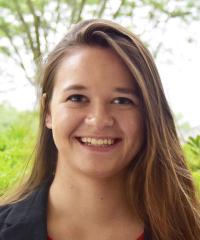You are here
Samantha Pedek
University of Wisconsin-River Falls
NASA Goddard Space Center Intern
NASA Goddard Space Flight Center
Position details
Cosmic Microwave Background Polarimetry
Recent cosmological results have indicated that the universe may have undergone a period of rapid accelerated expansion within its first fraction of a second. This expansion, known as cosmic inflation, would have produced primordial gravitational waves that imprint a faint telltale polarized signature on the relic cosmic microwave background radiation. NASA Goddard is currently developing technology for two pathfinder experiments to measure the polarization of the cosmic microwave background to search for evidence of cosmic inflation in the early universe. The enabling technologies currently under development include highly sensitive cryogenic detectors and quasioptical polarization modulators.
Samantha is working with the team to further the detector and modulator development. She is testing existing devices, analyzing test data, and designing laboratory test structures.
Final presentation
![]() Infrared Response of a Quasi-Crystalline Filter
Infrared Response of a Quasi-Crystalline Filter
There is an abundance of infrared radiation throughout the universe, which presents a challenge when studying the cosmic microwave background and other astronomical objects. In order for our team to study the cosmic microwave background polarization, the detectors need to be kept at approximately 0.1 Kelvin, and, if present, will warm the instrument. This thermal radiation can be mitigated by using an infrared filter. Traditionally, infrared metal mesh filters consist of several layers of a translationally symmetric tiling of squares are used to block radiation in large apertures. This approach can lead to diffraction at large angles, which, if present, can also create a pattern in the angular response. This decreases the angular resolution and beam symmetry, which is vital for polarimetry measurements. The main goal of this project was to design a filter with a different geometric tiling approach that has the potential to decrease diffraction at large angles. Instead of using a square tiling, this study uses a rotationally symmetric, tilling of pentagons. The resulting tiling is referred to as a non-periodic quasi crystal, meaning that it cannot be tiled in two dimensional translational space. In order to better understand the optical behavior of the quasi-crystalline tiling, a simplified version of the filter was primarily studied due to computational restrictions. The quasi-crystalline filter has been fully designed and is awaiting fabrication.
I am a senior at the University of Wisconsin-River Falls, in River Falls, Wisconsin, majoring in Physics. I am extremely excited and honored to have been selected to be one of the SPS NASA interns for this summer. The night sky has always fascinated me, even from a very young age, and I am passionate about learning more about the universe we live in. I have been fortunate to have had some prior research experience in astrophysics with IceCube, the one cubic kilometer neutrino “telescope” located at the South Pole. As I learn about the universe, my passion continues to grow, and I know working with NASA will only add fuel to the fire.
In my spare time, I love falling into adventures. I have developed a passion for travel, and staying in D.C. will only add to that. I enjoy casual hiking and basketball, trying new food, and playing an odd assortment of card and board games. I am currently the Treasurer of our local SPS chapter, and next year will be the Vice President. I was also recently elected as the Zone 9 Associate Zone Councilor. I am extremely excited for the wonderful opportunity to do research, and to work with outstanding people.

